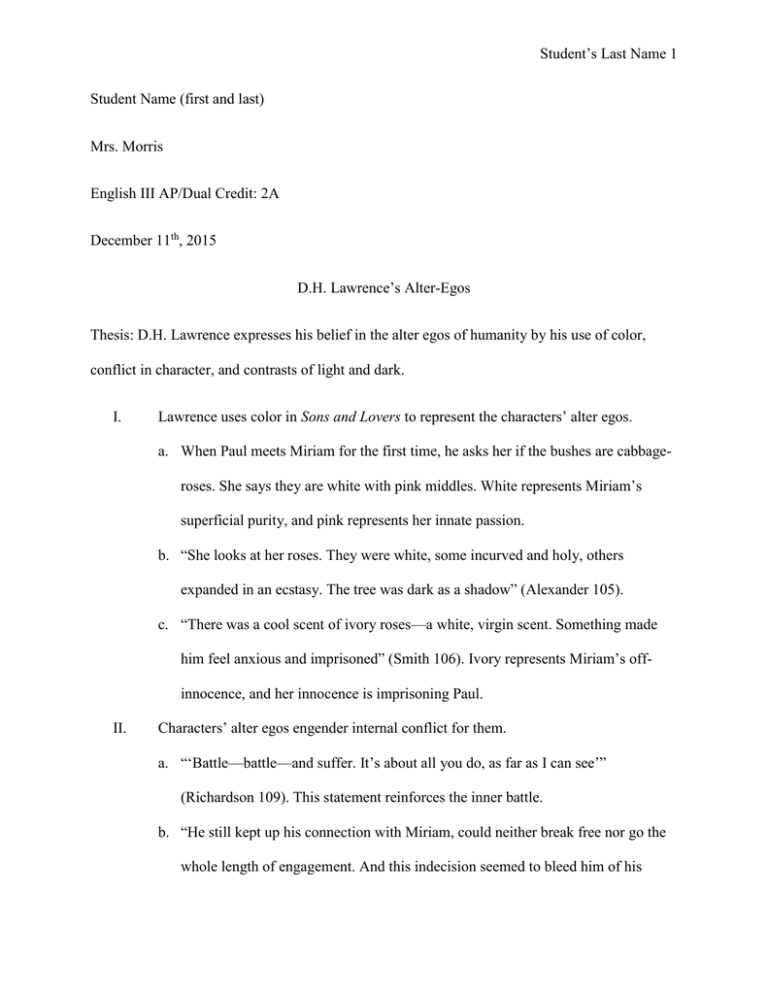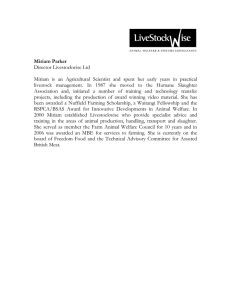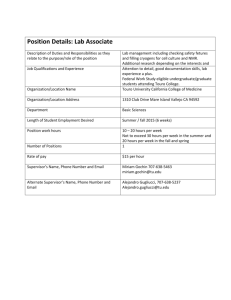Student’s Last Name 1 Student Name (first and last) Mrs. Morris
advertisement

Student’s Last Name 1 Student Name (first and last) Mrs. Morris English III AP/Dual Credit: 2A December 11th, 2015 D.H. Lawrence’s Alter-Egos Thesis: D.H. Lawrence expresses his belief in the alter egos of humanity by his use of color, conflict in character, and contrasts of light and dark. I. Lawrence uses color in Sons and Lovers to represent the characters’ alter egos. a. When Paul meets Miriam for the first time, he asks her if the bushes are cabbageroses. She says they are white with pink middles. White represents Miriam’s superficial purity, and pink represents her innate passion. b. “She looks at her roses. They were white, some incurved and holy, others expanded in an ecstasy. The tree was dark as a shadow” (Alexander 105). c. “There was a cool scent of ivory roses—a white, virgin scent. Something made him feel anxious and imprisoned” (Smith 106). Ivory represents Miriam’s offinnocence, and her innocence is imprisoning Paul. II. Characters’ alter egos engender internal conflict for them. a. “‘Battle—battle—and suffer. It’s about all you do, as far as I can see’” (Richardson 109). This statement reinforces the inner battle. b. “He still kept up his connection with Miriam, could neither break free nor go the whole length of engagement. And this indecision seemed to bleed him of his Student’s Last Name 2 energy” (Smith 140). The part of Paul that wants to be respectable forces him to maintain the engagement, but he secretly wants to break ties with Miriam and find someone else. III. Contrasts of light and dark imagery underscore the characters’ alter egos. a. “She stood beside him, forever in shadow. Her face, covered with the darkness of her hat, was watching him unseen. But she was brooding. She was slightly afraid—deeply moved and religious. That was her best state. He was impotent against it” (Jones 54). Miriam, like Paul, possesses an alter-ego. She has an inner, passionate self, but she represses it. b. At 5:00 at night in the countryside, Miriam and Paul finally break up and Paul at last feels peace. c. Paul loves to paint pictures. They are “full of light” (Homer 34). His break from Miriam has enabled Paul to embrace “light,” or optimism. He no longer feels stifled or smothered. IV. Although Lawrence never himself achieved inner harmony, Paul ends the novel with hope that he can harmonize his alter egos and live a satisfying life. Student’s Last Name 3 Works Cited Alexander, Roger. "An Inconvenient Truth." Rev. of An Inconvenient Truth, dir. Davis Guggenheim. rogerebert.com. Sun-Times News Group, 2 June 2006. Web. 24 May 2009. Homer, John. "Avoiding Self-organized Extinction: Toward a Co-evolutionary Economics of Sustainability." International Journal of Sustainable Development and World Ecology 14.1 (2007): 27-36. Print. Jones, Marcel. Global Warming: Myth Or Reality?: The Erring Ways of Climatology. New York: Springer, 2005. Print. Richardson, William D. "After Kyoto: Alternative Mechanisms to Control Global Warming." American Economic Review 96.2 (2006): 31-34. Print. Smith, Bret. "Putting a Price on Pollution." Usnews.com. US News & World Rept., 6 May 2007. Web. 24 May 2009.


